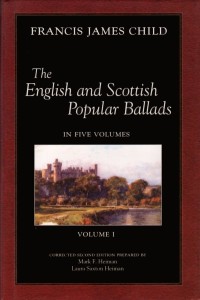 …true popular ballads are the spontaneous products of nature… — Francis James Child
…true popular ballads are the spontaneous products of nature… — Francis James Child
So it only took a century for a corrected edition of the first volume of the most famous ballad collection in the Anglo-Celtic tradition to be published. Was it worth the long wait? Oh, yes! Francis Child’s five-volume work, The English and Scottish Popular Ballads (1882-1898), is considered by many as the basis of traditional Anglo-Celtic folk music, as both the popular characters (like the mythical Tam Lin and the might-have-been-real Robin Hood), and the actual songs still played by many a musician, are contained within this work. And just as important, the Child Ballads are crucial to present-day writers who use the old folk ballads as a basis for their storytelling.
As I noted in my review of the Dover reprints of the Child Ballads:
Forget their role in ballad research for a moment, and revel instead in the ballads themselves. I mentioned the Tam Lin ballad before. Tam Lin — also known as Tamlene, Thomalyn, True Thomas, Thom of Lyn, and Thomlin — exists in at least four variant forms in the Child Ballads: “Lord Robinson’s Only Child,” “Janet of Carterhaugh,” “Tam Lin,” — yes, same name, but different verses — and “Tam Lane.” This ballad has inspired musicians for a century, including an inspired version by Frankie Armstrong backed by Blowzabella on her album Til The Grass O’er Grew The Corn, and it certainly has sparked the imaginations of writers interested in this folk ballad. I can think of a number of novels and stories based on Child Ballad #39: Tam Lin by Susan Cooper, Tam Lin by Pamela Dean, The Queen of Spells by Dahlov Zorach Ipcar, Fire and Hemlock by Diana Wynne Jones, ‘Tam Lin’ (in the graphic novel series Ballads and Sagas) edited by Charles Vess, and ‘Tam Lin’ by Joan D. Vinge (a short story that appeared in Imaginary Lands, edited by Robin McKinley).
I go on to note: ‘Likewise “Twa Corbies” (Child Ballad #26) has inspired countless writers and musicians, as the image of two crows conversing over a corpse is one of the most grimly evocative of all the songs associated with the Scottish Border with England. It conjures up images of the bleak Border fells with its underlying themes of betrayal and murder. Performers including Boiled in Lead, Annwn, the Wild Hunt, Kenneth McKella, Cannach, the Corries, Maddy Prior, Urban Myth, Steeleye Span, and Alan Prosser have covered “Twa Corbies” or variants. Writers such as Charles de Lint have also used “Twa Corbies” as the basis of their work. In Someplace to Be Flying, he created the Crow Girls, two immortal beings who are either black-dressed punk “teenagers” or crows depending on their mood. After writing Someplace to Be Flying, Charles wrote “Twa Corbies,” a tale that featured the Crow Girls as participants in a modern day version of “The Twa Corbies.” Charles Vess collaborated with Charles de Lint on a graphic version of de Lint’s “Twa Corbies.”‘
But finding these publications has been often next to impossible, and expensive to boot! There’s a copy of the 1880s edition for sale right now for a mere five thousand American dollars! Even the Dover softcover editions from the 1960s often cost close to a thousand American dollars for a full set in not terribly good shape. Laith, our librarian, says that the set of Princeton University Press hardcovers took her years to find — not surprising, given their scarcity. So a new edition’s long, long overdue.
But merely doing a new edition is not enough for these editors — they published, as they note on the Loomis House web site, ‘the first new (non-facsimile) edition of the Child collection, completely re-set and edited to include all of Professor Child’s post-publication corrections and additions. Volume I includes 77 ballad texts from the additions and sixty ballad tunes drawn from Child’s original sources.’ In other words, this is a far superior edition than either the Dover Books or Princeton University editions, which simply reprinted the error-ridden original editions. And it’s put in a handsome format that truly is one of the best publishing jobs that I’ve seen.
As I noted in my review of the Dover edition, the list of ballads that are in these books is almost endless. If you are deeply into fantasy fiction that uses folk motifs, or are a lover of traditional music, you should own a set of these newly published Child Ballads. A nice bonus is that they do include sixty ballad tunes drawn from Child’s original sources. (Child felt the words, not the music, were the ‘real’ ballad.) Any fiddler worth hearing will find much to learn from these tunes. And folklorists, traditional music lovers, storytellers, and just about everyone else who likes any aspect of what these ballads are should own this new edition. Even if you now own the Dover editions, these are a must as they are better in every way possible!
(Loomis House Press, 2002)
